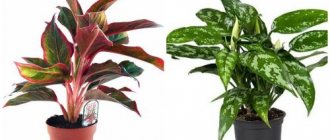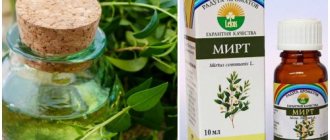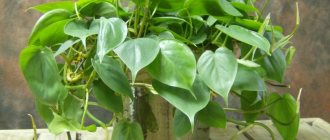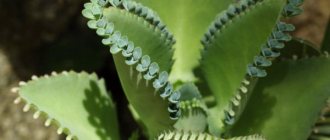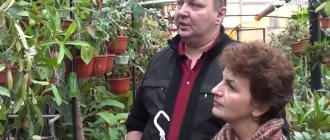This ornamental plant resembles Dieffenbachia in appearance, but catches the eye with its majestic leaves, decorated with elegant patterns. Its magnificent, colorful, variegated leaves effectively decorate apartments and semi-shaded shelves. It looks fantastic in interiors, grows quickly and does not require special care. It is enough to provide her with a suitable position and take care of the correct temperature and moisture. Find out how to properly grow aglaonema - care at home, how to transplant and propagate, what conditions it needs.
Description of Aglaonema
The home flower Aglaonema is an evergreen herbaceous plant. The short and straight stem is quite fleshy. There are species in which the trunk begins to branch at the base.
Aglaonema nitidum
The stem is present only in mature plants, and its formation occurs due to the flight of the lower leaf plates. The color of the foliage directly depends on the type and variety of the plant. The shape of the dense, leathery leaf plates to the touch is ovoid or lanceolate. They are attached to the trunk by petioles, which can be long or short.
The edge of the leaves is solid, while the plate is patterned, and on its front surface there is a depressed midrib, while on the reverse side it is convex. At the top of the plant, from the axils of the leaves grow from 1 to 3 ears with a greenish-white cover; they are the inflorescences of aglaonema.
Depending on the type of plant, the cobs are divided into 2 types:
- thick club-shaped - reach 10 mm in diameter and their length is 40 mm;
- thin cylindrical - their length is about 60 mm, and their diameter reaches 5 mm.
The fruit is a juicy berry, inside of which there is 1 seed, which has a rich orange or white color. The berries ripen after 6–8 months.
Aglaonema Blooming
Lighting, choice of location
In its natural environment, aglaonema grows in the shade of large plants, so it is better to place the pot in partial shade in the house. The flower is light-loving, but direct rays are destructive to delicate leaves and can leave burns on them.
Note! Purchased specimens cannot be immediately placed on the windowsill. They need adaptation to natural light within 1–2 weeks.
The ideal place for the pot would be an eastern or western window sill. On the south window you will have to shade it with tulle, larger plants or place it at a short distance from the light source.
Variegated varieties turn pale from lack of light and lose color, becoming monochromatic.
How does aglaonema bloom?
Aglaonema flower
Aglaonema blooms luxuriantly, but the flowers are inconspicuous, collected in an inflorescence - a spadix, from which small fruits may appear - berries of orange, red or even white color.
Each ear can remain open and attractive for up to 2 weeks.
To prevent plants from wasting energy on flowering, the buds are often pinched as soon as they appear. The fruits are poisonous!
In its homeland, in Southeast Asia, aglaonema blooms in the summer - from June to August. However, in our latitudes, the flowering period can be greatly shifted towards winter and occur from approximately November to February. When kept indoors, some types of aglaonema bloom quite rarely. And if all the advice on its maintenance is not followed, if it does not die, it may stop blooming altogether.
Beneficial features
It humidifies the air in the room. Reduces the level of toxic substances released by new furniture and gas stoves. Some species disinfect the air, clearing it of anaerobic bacteria. During a period of intensive growth, a flower releases air ions that cause a charge of vigor and increase resistance to stress.
Aglaonema: home care
This tropical plant grows in places with limited access to light. For this reason, it does not tolerate direct sunlight.
At home, caring for aglaonema consists of observing the conditions of temperature, lighting and watering conditions. If the leaves of Aglaonema turn yellow and become spotted, then you need to pay attention to the quality of the water. What to do if the leaves turn yellow? Check the chlorine content in the water.
Watering
Since this plant is accustomed to tropical climates, the soil must be regularly moistened. The regularity depends on how shaded the plant is: the darker it is, the less water is required. Boiled water at room temperature is ideal for irrigation.
Watering and spraying anglaonema
Spraying
The tropics are characterized by high air humidity. To make indoor aglaonema feel comfortable, you need to spray the plant twice every 14 days in the summer, take a warm shower, or wipe the leaves with a damp cloth more often. Just don’t allow moisture to accumulate in the rosette of leaves: this can lead to the death of the plant.
In winter, spraying is carried out less frequently, but the flower is placed in a tray with moistened expanded clay or pebbles. During the heating season, the flower is kept away from radiators, air humidifiers are used, or an open container of water is placed nearby.
Premises requirements
The best temperature for the growth of this exotic plant is +20…+25 C. Sudden temperature changes should be avoided. The humidity in the room determines how bright and large the leaves will be, which curl and wrinkle in dry air. The plant should also be protected from drafts, but the room should be well ventilated.
Lighting
Avoid exposing the leaves to direct sunlight as this can cause burns. The plant loves partial shade. For species with leaf patterns, diffused sunlight is required, otherwise the pattern may disappear.
Air humidity
For aglaonema, home care also includes maintaining air humidity. To prevent the leaves from turning yellow, the humidity should be more than moderate. Don't forget to spray the plant regularly. To increase humidity, you can place the pot on a tray with moistened peat or pebbles.
Temperature
As mentioned above, a comfortable temperature for keeping a plant is from +20 to +25 C, and in winter not lower than -16...-18 C. The plant does not tolerate sudden temperature changes.
The soil
For successful flower growth, the soil must be well permeable to moisture and air. The soil may consist of a mixture of leaves, humus, sand, peat and charcoal.
The flower grows well in acidic, loose soil. These characteristics correspond to the ready-made soil mixture for bulbous plants. You can make the soil yourself by taking garden soil, peat, perlite (1: 2: 1), and put 2 times more leafy soil for young bushes.
You can add charcoal to the mixture. For mature plants, the amount of turf soil can be increased.
Fertilizer and feeding
Feeding and fertilizing with mineral and organic substances is an important component of flower care. Aglaonema is fertilized once every 2 weeks with liquid formulations for decorative foliage plants, containing not only the main elements, potassium, phosphorus and nitrogen, but also microelements that prevent alkalization of the soil.
To preserve the decorative appearance of the foliage, foliar feeding is carried out: the leaves are sprayed with diluted liquid fertilizer. It is best to do this after watering in cloudy weather, so as not to accidentally burn the plant. All feeding is carried out from the beginning of March to the beginning of October.
You cannot fertilize in winter, because the plant is resting at this time.
Aglaonema transplant
Aglaonema transplant
Aglaonema is transplanted for the first time a week after purchase. When it adapts a little to home conditions, it is transferred from a temporary pot to a permanent container.
Young bushes are replanted once a year, adults - once every 4 years. Replanting aglaonema is necessary when the roots completely entwine the earthen ball. It is always produced in the spring. A new pot is chosen 20 - 30 mm larger than the previous one.
It must have drainage holes and a place to pour a thick layer of drainage, which is necessary so that the water in the pot does not stagnate. The soil is carefully selected, taking into account that it loves acidic and loose soil. The soil mixture should include turf soil (an adult bush can put more of it), peat, leaf soil, charcoal and perlite (sand).
Trimming
When aglaonema grows, its trunk becomes exposed. This suggests that the flower needs pruning, with the help of which its rejuvenation is carried out. Cut off the top of the plant with a sharp knife, and dust the cut areas with charcoal powder. The stump is left in the pot.
They continue to take care of it and wait for renewal buds to appear. And the top is rooted in water in which activated carbon is pre-dissolved to avoid souring. Sometimes the top is immediately planted in moist soil. Cover with polyethylene and keep at a temperature of +25°C until rooting.
Homemade aglaonema does not require special care; if properly maintained, it will grow healthy and become a real decoration of the interior.
Rest period
Like most plants, the dormant period of aglaonema falls in the winter. At this time, they reduce the amount of watering and stop stimulating growth with fertilizers and fertilizing.
Possible difficulties
At home, violation of the care of aglaonema is visible to the naked eye by the condition of the leaves. The reason for wrinkled leaves lies in too dry air and soil, and if they curl, then you need to pay attention to drafts and air temperature. A lack of light is immediately noted by the leaves turning yellow, and white-yellow spots indicate sunburn. Gray plaque is a signal of gray mold disease.
Reviews
A relative of Dieffenbachia, the plant Aglaonema, came to me several years ago. <…> Over the course of several years, the plant grew longer and the color became less variegated, so I grew a new one from a tip cutting, which was not difficult to do. I like this indoor flower because it does not require special care, effectively purifies indoor air, and reduces the content of harmful substances that enter the apartment.
tamarav https://spasibovsem.ru/responses/rodstvennitsa-diffenbahii.html
I really like Aglaonemas for their unpretentiousness and variety of colors. For about two years I tried to root several different varieties. Unfortunately, they didn't want to grow. She fed, sprayed, tried to find the most suitable place. Everything was useless. I decided to tackle the root system. For six months I watered it with Ribav and Zircon (to form a root system). The result was not long in coming.
irulchik https://myfl.ru/category/nazvanie-rasteniya/aglaonema
My aglaonemas appeared not so long ago, but the red color is completely preserved. I think that in good lighting conditions it will not disappear. Shrinking of leaves, disappearance of variegation - these are similar to signs of insufficient lighting. In my opinion, red aglaonema, like its less colorful relatives, is a very unpretentious plant. It has a lot of advantages - it tolerates overdrying, low humidity, heat and at the same time does not dry out the tips of the leaves and retains an attractive appearance. In general, I am a fan of this plant, like all others with beautiful leaves.
Vanda https://flo.com.ua/forum/viewtopic.php?t=17400
Types of aglaonema
Aglaonema nitidum
Aglaonema nitidum
This species is native to damp forests located on the plains of Thailand, Malaysia, Sumatra and Kalimantan. The trunk height is about 100 cm. The length of the rich green or dark green leaf plates is about 45 centimeters, and the width is 20 centimeters. Their shape is oblong, and the front surface is shiny. Inflorescences consist of 2–5 flowers. The length of the cob is 60 mm, it is covered by a blanket of almost the same length. The berries are white.
Aglaonema commutatum, or aglaonema changeable
Aglaonema commutatum
The plant is native to the Philippines and Sulawesi. The length of the straight stem can vary from 0.2 to 1.5 m. Long-petioled leaf plates reach 30 centimeters in length and 10 centimeters in width. Inflorescences consist of 3–6 flowers. The length of the thin cob is 60 mm, it is covered by a longer greenish blanket. When red fruits form, the bush looks more impressive. Varieties:
- warburgii - white stripes run along the lateral veins on the leaf blade;
- elegans - on the elongated oval greenish leaf blades there is a pattern of light green color;
- maculatum - on the surface of the dark green elongated oval leaf blades there are white strokes.
Aglaonema oblong-leaved (Aglaonema marantifolium)
Aglaonema oblong-leaved (Aglaonema marantifolium)
The plant comes from the tropical rainforests of Singapore and the Philippines, as well as the islands of Borneo and Penang. The length of large dark green leaf plates is about 0.3 m. They have petioles reaching 0.2 m in length. Some varieties have a gray-silver pattern on the surface of the foliage.
Aglaonema pictum
Aglaonema pictum
The species is native to rainforests located on the islands of Sumatra and Borneo. The height of the branching trunk is about 0.6 m. The shape of the dark green large leaf plates is elongated and elliptical. Gray spots are unevenly distributed on their surface. In some varieties, these spots are silvery-white. The berries are red.
Aglaonema costatum
Aglaonema costatum
Native to rainforests located in the tropical part of South-West Malaysia. This herbaceous plant has a trunk that branches at the base. The length of the leaf plates is about 20 centimeters and the width is 10 centimeters. On the surface of the dense green foliage there are specks and streaks of white color.
Aglaonema modestum, or moderate aglaonema
Aglaonema modestum
The species is native to humid forests located on the mountain slopes of the tropical part of Indochina and the Malay Archipelago. The height of the branching trunk is about 50 cm. The oval green leaves have a blunt base and a sharp apex, they reach 20 centimeters in length and 9 centimeters in width. On each side of the central vein there are several pieces of convex side veins. The red berries are similar to dogwood fruits.
Anti-aging pruning
As the trunk grows, it gradually becomes bare and the aglaonema loses its decorative effect. Therefore, flower growers recommend anti-aging pruning. Typically, the procedure is required for specimens older than five years.
The upper part is cut off so that all the leaves and part of the bare stem remain on it. The cut areas are dried a little, and then sprinkled with charcoal or covered with paraffin.
The hemp in the pot is covered with a bag and put in a warm, bright place until the buds appear. The bag is regularly removed and condensation is removed.
The top is rooted in soil mixture or water with stimulants. Thus, it will be possible not only to renew the old bush, but also to grow a new aglaonema.
Actually, this is how the flower reproduces. Therefore, this section will not be included, since it is simple and even a beginner can handle it. You just have to want it and you will succeed.
Reproduction
The plant reproduces well in almost all popular ways: cuttings, seeds, root division.
Propagation by Agloanema cuttings
Propagation by cuttings
Reproduction in this way is best done in the spring. The apical cutting cut off during pruning can be used for propagation. To do this, divide it into several parts 10-15 cm in length, so that each part has leaves.
Treat the cut areas with crushed charcoal. Leave the cuttings in the fresh air for a day to dry. Then place the planting material in a container with a damp substrate (consisting of peat and sand), deepening it to 5 cm.
It is recommended to cover the cuttings with a transparent bag or glass lid to create greenhouse conditions. Place the container in a warm place with a temperature of 22-25 degrees. Do not forget to ventilate the greenhouse and, if necessary, moisten the substrate.
In about a month, the cuttings will give roots. When this happens, transplant them into separate pots filled with soil for adult plants, and care for them according to all the rules for caring for aglaonema.
Growing from seeds
Aglaonema from seeds
This method does not guarantee the preservation of the varietal characteristics of the parent specimen. Aglaonema seeds can either be bought in a store or obtained independently, because it happens that the plant self-pollinates.
In this case, after inconspicuous flowering, fruits in the form of berries are formed on your flower. Their color can be any shade from yellow to red, depending on the variety.
Do not pick the berries until they are ripe. The pulp of the fruit contains seeds. Once ripe, remove them and rinse well with water.
Just don't wash them over the sink, otherwise you risk losing the planting material, which can easily slip through your fingers.
We recommend sowing the seeds immediately, as they quickly lose their viability. Fill the container with a mixture of peat and sand in proportions 1:1, water it, and sow the seeds into it. Place the container in a warm place and wait for the shoots to appear. They will appear relatively quickly.
As soon as the first true leaves appear on them, pick the seedlings into separate cups. When they grow up, they can be transplanted into separate pots with substrate for adult specimens.
They will become full-fledged fluffy bushes after 3-4 years.
Reproduction by root division
Reproduction of aglaonema by root division
Adult, strongly grown specimens with a healthy and well-developed root system are suitable for this method of propagation. It is convenient to propagate aglaonema by dividing the root during transplantation.
- After removing the bush from the pot, shake off the earthen lump, rinse the roots with water and carefully inspect them. Remove damaged areas, if any.
- Using a sharp knife or scissors, divide the rhizome into the required number of parts so that each of them has healthy shoots and at least 3 leaves.
- Sprinkle the cut areas with crushed activated charcoal or charcoal.
- Plant each of the resulting specimens in pre-prepared pots according to the rules specified in the “Transplanting” paragraph, water well.
- Place in a warm place, water and spray.
- Evidence that the plant has taken root normally and is not diseased will be the appearance of young leaves. Then you can put the pot in a permanent place.
Watering schedule, air humidity
Aglaonema is sensitive to the composition of water. To water it, it is better to use warm, filtered, bottled or settled water. Increased rigidity will lead to loss of decorativeness.
During the growing season, the flower is watered only when the top layer of soil has dried out 3–4 cm deep. But it is worth considering that flooding is just as harmful as drought and monitoring the condition of the earthen clod and roots. At this time, the leaves are sprayed daily, and expanded clay, pebbles or moss are poured into the tray, which are regularly moistened.
During dormancy, watering is reduced to once a week, but only if the plant is kept in a room with a temperature no higher than +16 °C. If the flower does not “fall asleep,” then the watering schedule remains the same.
Diseases and pests
Spider mite on aglaonema
Aglaonema can be attacked by:
- Spider mite. It affects leaves and stems on which cobwebs appear. Treatment consists of spraying with Actellik or Akarin.
- Mealybug. White fluffy pests on stems and leaves. As a result of their invasion, the leaves dry out, curl and fall off. Insecticides such as Actellik, Fitoverm, Fazol will help in the fight against them. Use them strictly following the instructions on the packages.
- Aphid. It affects the leaves, they become sticky and deformed. Treatment consists of spraying with Decis or Aktara.
- Whitefly. Small flying insects are white. They live on the underside of leaves. Use Confidor, Mospilan (1 treatment) or Actellik (up to 4 treatments every 5-6 days). Common means of repelling flying insects - a fumigator and adhesive tape - can also help.
- Shield. It can be seen with the naked eye. These are brown tubercles located on the leaves and stems of the plant. Scale insects should be removed manually, removing each specimen using a damp cloth soaked in a soapy solution. The procedure must be repeated several times with an interval of 3-4 days, since after the first time larvae may remain.
- Thrips. These are very small insects located on the back of the leaf. Thrips larvae are found in the soil, so the first step is to remove and discard the top layer of soil from the aglaonema pot. Then wipe the leaves and stems with a sponge and soapy water, and after 4 hours, spray with Fitoverm solution.
Aglaonema is not susceptible to disease, but improper care can cause some difficulties in growing.
- The leaves begin to wrinkle and the edges turn brown. This is due to dry air. The plant must be moved to a more humid room or sprayed with a spray bottle.
- The leaves curl. The reason may be the appearance of drafts in the room. In this case, the plant must be moved to another room, or drafts must be eliminated.
- The appearance of yellow spots. This is a consequence of sunburn. Most likely, the plant is standing in a sunny window, which is harmful to its health. It is advisable to change the place of residence of the aglaonema or shade it.
- Plant growth stops and brown tips appear on the leaves. This may be due to cold or hard water. Water the plant only with settled water at room temperature. If watering is carried out correctly, then the reason is the hardness of the water; to lower the level, you can add citric acid to the water (dilute 1-2 g in 1 liter of water).
Possible problems during cultivation
Pests common to indoor plants may appear on aglaonema:
- thrips;
- spider mites;
- scale insects;
- scale insects;
- rarely - aphids or whiteflies.
For control, insecticides are used, for example, Aktelik. If owners want to use new odorless preparations, when fighting spider mites, they need to make sure that they have an acaricidal effect. This is not an insect, but an arachnid.
Of the diseases, the most dangerous are rot:
- root when growing aglaonema in dense soil, without drainage or lower holes in the pot;
- leaves arising due to the transfer of fungus from other plants, or spraying at low temperatures.
They get rid of infections of the aerial parts by treating them with appropriate fungicides. If the root begins to rot, you will have to root the top.
Other problems:
- leaves curl - cold;
- the plates are wrinkled - dry air;
- brown tips - the same;
- whitish spots on the leaves – sunburn;
- dark marks on the plates are the result of waterlogging of the soil;
- the bush turned black - hypothermia.
Signs associated with flowers
Aglaonema is believed to bring good luck to its owner. This is connected with the story of a large cash prize: a man looked at the numbers on the leaves of aglaonema in the garden, indicated them when buying a lottery ticket and won.
In addition, aglaonema is believed to increase performance and concentration. Scientists say that its leaves purify the air and can destroy streptococci.
Sources and literature
Sources and literature
- Botany. Encyclopedia “All the Plants of the World”: Trans. from English / Ed. Grigorieva D. et al. - Könemann, 2006 (Russian edition). — P. 68-69.
- D. Hessayon. All about indoor plants. - M.: Kladez-Books, 2001
- Grudzinskaya I. A. The arum family (Araceae) // Plant Life. In 6 t / Under. ed. Takhtadzhyan A.L. - M.: Education, 1982. - T. 6. Flowering plants. — P. 471.
- Houseplants / T. M. Klevenskaya // Great Soviet Encyclopedia: [in 30 volumes] / ch. ed. A. M. Prokhorov. — 3rd ed. - M.: Soviet Encyclopedia, 1969-1978
- Saakov S.G. Greenhouse and indoor plants and their care / Under. ed. Kamelina R.V. - L.: Nauka, 1983. - P. 132-134. — 621 p.
Formation of a spreading crown
Some new gardeners complain that their “favorite” does not branch or grow. There may be several reasons, but there are tricks that will help make the crown more luxuriant.
Recommendations:
- the pot should be tight and exceed the volume of the earthen ball by only 2–3 cm;
- pinching the upper buds stimulates the growth of lateral shoots;
- overgrown, but not very branched shoots are cut at a distance of 6–7 cm from the ground, rooted and planted next to the mother bush.
Rest period
The dormant period of Aglaonema is weak; if the temperature in winter remains within +18-+23 °C, the plant will not “fall asleep”. In this case, there is no need to reduce watering and lighting. But it is better to postpone fertilizing until spring.
The winter dormancy period begins around October. It is necessary to gradually reduce the temperature to +14 °C, reduce watering to once a week, but at the same time regularly spray the bushes with warm water. In this condition, the pot can stand until the end of February.
It is necessary to monitor the condition of the flower and prevent the soil from drying out. If the plant begins to wither and wither, then you need to “awaken” it ahead of schedule.
